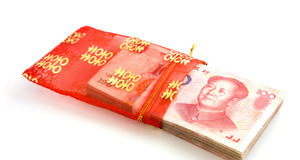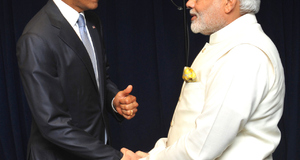From Cornell International Affairs Review VOL. 1 NO. 2Indo-Pakistani Enmity & the Reorganization of Asia: Strategic Opportunities for China and IndiaCurrent Issues Could Lead to a Situation More Favorable to India at the Expense of PakistanEconomic concerns and regional frameworks are now important issues that could enhance India’s appeal at the expense of Pakistan in the strategic thinking of China. However, this will largely depend on India’s own strategic choices among the different options for the reorganization of Asia. How could India’s rise play out on the Indo-Pakistani conflict?Beijing likes to say that economic development is now its first priority. As India develops, India becomes an attractive market for Chinese goods- more than Pakistan could probably ever be. In November 2006, China signed a free trade agreement (FTA) with Pakistan that aims to triple bilateral trade in the next five years. But Pakistan’s GDP growth (around 4.5%) is slower than that of India, and the country suffers from instability and inflation. If India maintains its faster development, China might decide to increase its ties to India at the expense of Pakistan, though this is still uncertain: China could see India as a competitor rather than a partner. The current political situation of Pakistan is another factor that could lead China to become more favourable to India. Pakistan was suspended from the Commonwealth of Nations on November 22, 2007, three weeks after President Musharraf imposed martial law. The assassination of Benazir Bhutto on December 27, 2007, leader of the Pakistan Peoples Party (PPP), also hints that the road to democracy will be long and difficult. Though the PPP emerged as the largest party on February 18, 2008, no political party was able to secure a majority in the Parliament. With Musharraf refusing to resign despite his party’s bad results, it is unclear whether the unpopular present will be able to govern the country. The violence of Pakistani politics also seems to have become enduring. For instance, less than one week after the elections, the surgeon general of the Pakistani Army, Mushtaq Ahmad Baid was killed in a suicide attack. Because Pakistan currently gives the impression of an unstable and violent country, India may appear as an increasingly interesting partner to China. Opportunities for increased regionalism and consequences on the Indo-Pakistani conflictChina and Japan both wish to increase regionalism in Asia, but they compete as to how to design this regional framework. Since the formation of ASEAN +3 in 1997, Japan has found China’s voice too powerful in the forum. In consequence Japan has strengthened its alliance with the US and called for “open regionalism,” materialized in 2005 by the formation of the East Asian Summit (EAS) that included Australia, New Zealand and India. The inclusion of India strategically made it more difficult for China to lead unilaterally (Rozman). Moreover, Japan wanted these inclusions to increase the importance of democracy in the framework, hoping to isolate China. This may play out on the Indo-Pakistani issue: If Japan becomes increasingly concerned about supporting democracy in Asia, this will play in the favor of India at the expense of Pakistan. China, however, perceived that Japan wished to counter its importance, and therefore has become wary of the EAS and of Japan’s plan to create a democratic Japan-US-India-Australia axis. China could try to avoid the formation of such a quadrangle by moving closer to India, distancing itself from Pakistan. How could India reorganize the region? India’s multiple options regarding Pakistan and their consequencesIf it is difficult to foresee China’s future positioning on the Indo- Pakistani issue, it is because India is itself an increasingly essential actor, capable of choosing how Asia may be reorganized. To become a global power, India must decrease the importance of Pakistan in its strategic thinking, so that “It would not be a question as it is now of Indian power minus Pakistani power, but of an India free to exercise its influence over a much wider range” (Cohen). India has many options to do so. First, it could ease the tensions with Pakistan by engaging the country through the multiplication of economic ties. In 2000, trade with Pakistan constituted only 0.21% of India’s total trade, and trade with India was 1.25 % of Pakistan’s total trade (Sridharan). More economics links could produce a spill-over into security-issues and put an end to India’s paranoia. Other options seek not to engage but on the contrary to further isolate Pakistan to diminish its strategic importance. India can continue to engage China hoping that it will abandon Pakistan. If India manages to untie the Sino-Pak “entente cordiale,” Primakov’s concept of an India-Russia-China triangle of cooperation might even become successful. Alternatively, to push aside the burden of Kashmir, India could make better use of the existing regional frameworks: It could develop continental ties with the SCO and maritime ties with the EAS to isolate Pakistan. Last, India could isolate Pakistan by becoming closer to Japan at the expense of China. Eventually it could form a democratic axis US- Japan- Australia- India to isolate non-democratic countries such as China and Pakistan. India could then loosen its “one China foreign policy” and develop closer ties to Taiwan. “A healthy relationship with Taiwan will not only further its own strategic and economic interests but also checkmate China”(Nanda). These different options show that India has become the “swing state” (Gupta) that can make important decisions about the reorganization of Asia. Yet when choosing among these options, India will surely examine which one offers the most guarantees against the Pakistani threat- only then may India become an Asian power. The “Pakistani factor” has been the main concern shaping India’s foreign policy since 1947. China has recognized the structural nature of the Indo-Pakistani enmity and exploited it to its advantage. With the end of the Cold War, the nuclear tests and the War on terror, the conflict’s very nature has changed and China has adapted its stance on the conflict to its evolving strategic interests. Current issues of importance, such as economic development and regionalism suggest that China may choose a stance more favorable to India at the expense of Pakistan. But this will depend critically on India’s own strategic choices. India has indeed increasingly become an actor, “a swing state” capable of choosing among different options for the reorganization of Asia which one will best diminish Pakistan’s strategic importance. Only once India becomes less “Pakcentrik” will India be able to become an Asian power and find “its rightful place in the emerging world order.” ReferencesAndersen, W., Recent trends in Indian foreign policy, Asian Survey, Vol 41, 2001 Andersen, W. South Asia: a selective war on terrorism IN Strategic Asia 2004-05, ed. by A. Tellis et al, Washington, DC: National Bureau of Asian Research, pp. 227-59 Bouton, M, Oldenburg,P. India Briefing, A transformative fifty years, 1999 Cohen, S. India : Emerging Power, Brookings Institution Press, 2001, Washington Deepak B.R., Sino-Pak “Entente Cordiale” and India : A look into the Past and future. China Report, 2006 Gill, J. India and Pakistan IN Strategic Asia 2005, Seattle, WA: National Bureau of Asian Research, 2005/05, pp. 237-267 Gupta, A., US-India-China, Assessing Tripolarity, China Report, 2006 Vol 42, New Delhi Limaye, S.P, Tokyo’s Dynamic Diplomacy: Japan and the Subcontinent’s Nuclear Tests, Contemporary Southeast Asia, Vol. 22, 2000 Lounev, S. Russian-Indian relations in Central Asia IN Islam, oil and geopolitics, ed. by E. Davis et al., Lanham, MD: Rowman and &Littlefield, 2007, chapt. 12, pp. 173-86 Malik, M., The China factor in the India Pakistan Conflict, Parameters, 2003 Nayar, B. India in 2005: India rising, but uphill road ahead Asian survey, vo. 46, no. 1, Jan/Feb 2006, pp. 95-106 Nanda, P., India and its Taiwan Policy, China Brief. Vol 3 , 2003-Raman, B., India, Japan & China, talk delivered on April 27, 2007, South Asia Analysis group Rajamony, V., India- China- US triangle, A soft Balance of Power System in the Making? Centre for Strategic and International Studies, 2002 Rozman, G., Japanese strategic thinking on Regionalism, IN Japanese Strategic Thought toward Asia, edited by Gilbert Rozman et al, New York, NY: Palgrave Macmillan, 2007 Sinha, S., The Strategic Triangle India China Pakistan, China Report, 2004 Sridharan, E.Improving Indo-Pakistan relations ; international relations theory, nuclear deterrence and possibilities for economic cooperation, Contemporary South Asia, September 2005 Suggested Reading from Inquiries Journal
Inquiries Journal provides undergraduate and graduate students around the world a platform for the wide dissemination of academic work over a range of core disciplines. Representing the work of students from hundreds of institutions around the globe, Inquiries Journal's large database of academic articles is completely free. Learn more | Blog | Submit Latest in Political Science |




















